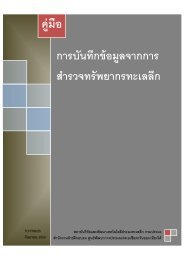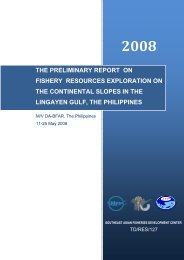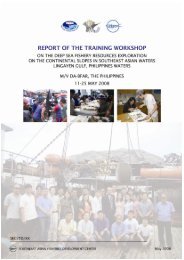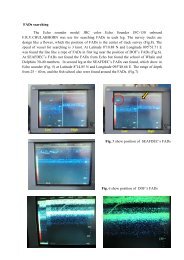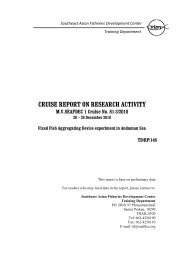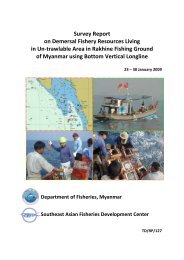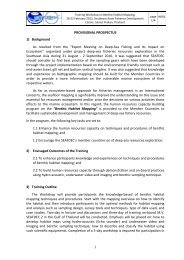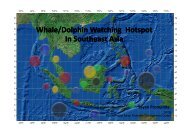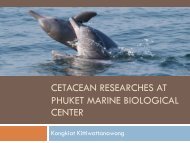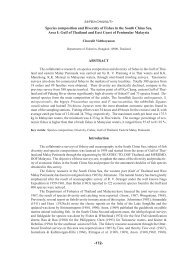019-stomach content-Praulai.pdf - fisheries information system ...
019-stomach content-Praulai.pdf - fisheries information system ...
019-stomach content-Praulai.pdf - fisheries information system ...
Create successful ePaper yourself
Turn your PDF publications into a flip-book with our unique Google optimized e-Paper software.
The Eco<strong>system</strong>-Based Fishery Management in the Bay of Bengal<br />
Stomach Content of the Large Pelagic Fishes<br />
in the Bay of Bengal<br />
Montri Sumontha 1 , <strong>Praulai</strong> Nootmorn 1 , Pornanan Keereerut 1 ,<br />
Rangkiri P.P. Krishantha Jayasinghe. 2 ,<br />
Nalla Jagannath 3 and Manas Kumar Sinha 4<br />
1 Andaman Sea Fisheries Research and Development Center,<br />
Department of Fisheries, Phuket 83000, THAILAND<br />
2 National Aquatic Resource Research and Development Agency,<br />
Crow Island, Colombo 15, SRI LANKA<br />
3 Office of the Zonal Director, Visakhapatnam Base of Fishery Survey of India,<br />
Fishing Harbor, Beach Road, Vusakhapatnam-530001, INDIA<br />
4 Port Blair Base of Fishery Survey of India, P.O.Box 46, Phoenix Bay, Port Blair, INDIA<br />
Abstract<br />
Investigation of <strong>stomach</strong> <strong>content</strong>s of apex predator; frigate tuna (Auxis thazard),<br />
skipjack tuna (Kasuwonus pelamis), yellowfin tuna (Thunnus albacares), bigeye (Thunnus<br />
obesus) and swordfish (Xiphias gladius) were undertaken during November to December<br />
2007. These fishes were caught in the Bay of Bengal with pelagic longline and drift gillnet<br />
from the survey cruise by MV. SEAFDEC.<br />
Thirty five percent of 68 <strong>stomach</strong> samples of tuna and tuna-like species were<br />
found diet. The diet <strong>content</strong> were reported cephalopod (60.70% by weight and 44.83% by<br />
number), fish (38.85% by weight, 5.75% by number), and parasite (0.45% by weight, 49.42%<br />
by number). Prey fish composed of 3 families; Ostraciidae, Bramidae and Diretmidae, and 1<br />
unidentified fish. Cephalopod was represented by Teuthoidea and Histioteuthis celetaria<br />
pacifica, Octopoda. Parasite was reported Nematode (black and white) and Digenea. Diet<br />
data were compared between surface and deep swimmer predators, the result showed higher<br />
the number of prey fish and parasite from deep swimmers (4.79 prey fish and 5.07 parasite<br />
per <strong>stomach</strong>) than that from surface swimmers (1.62 prey fish and 1.15 parasite per <strong>stomach</strong>).<br />
Community of predator, prey and parasite was categorized into 3 assemblages<br />
upon species of such components and habitat (depth of water) of those species. It was found<br />
significant differences between groups. Groups B and C had the highest total number of taxon<br />
whilst the highest average number of parasite was found in group B, followed by groups C<br />
and A.<br />
The preliminary structure of tuna trophic ecology in the Bay of Bengal was<br />
explained from the result of the present study. Future development on commercial deep-water<br />
<strong>fisheries</strong> and the taxonomy and field guide of deep-sea fishes and cephalopod beak have been<br />
suggested for the study in the Bay of Bengal.<br />
Introduction<br />
The predator-prey interactions play an important part in the structure and the<br />
dynamics of multispecies communities. Facing the dramatic increase of the catches of tuna<br />
and related species in the Indian Ocean, especially the eastern Indian Ocean, it becomes<br />
necessary to assess the impact of the <strong>fisheries</strong> on the pelagic eco<strong>system</strong>s. The implement of<br />
research activities leading to a better knowledge of trophic ecology of apex predators will<br />
provide such an eco<strong>system</strong> point of view that has to be considered nowadays in the high seas<br />
<strong>fisheries</strong> management.<br />
206
The Eco<strong>system</strong>-Based Fishery Management in the Bay of Bengal<br />
Feeding studies of tunas and sharks have already been conducted in the western<br />
Indian Ocean during the THETIS program (Potier et al., 2004) whereas the tunas feeding<br />
habit in the eastern Indian Ocean is still rarely studied, only the reports on <strong>stomach</strong> <strong>content</strong> of<br />
tropical tunas in the Andaman Sea (Nootmorn et al., 2007 and Panjarat, 2006) are available.<br />
. The purpose of this study considers on the <strong>stomach</strong> <strong>content</strong> of large pelagic fish,<br />
apex predator, in the Bay of Bengal.<br />
On Board<br />
Materials and Methods<br />
During M.V. SEAFDEC cruise two fishing gears, namely pelagic longline and<br />
drift gillnet, were operated for large pelagic fish catching in 3 areas of the Bay of Bengal (Fig.<br />
1); area A (Bangladesh, latitude 16 ° N-19 ° N, longitude 88 ° E-91 ° E), area B (Indian, latitude<br />
9 ° N-14 ° N, longitude 82 ° E-85 ° E) and area C (Myanmar, latitude 9 ° N-13 ° N, longitude 95 ° E-<br />
97 ° E). Large pelagic fish sample from pelagic longline and drift gillnet fishing were collected<br />
where the sampling sites are presented in table 1. Sixty eight fish samples comprised mainly<br />
28 skipjack tuna (Kasuwonus pelamis), followed by 15 swordfish (Xiphias gladius), 10 frigate<br />
tuna (Auxis thazard), 7 kawakawa (Euthynnus affinis), 5 yellowfin tuna (Thunnus albacares)<br />
and 3 bigeye tuna (Thunnus obesus). The entire <strong>stomach</strong> was removed from the freshly caught<br />
fish when hauled on board. Sizes of the predator in fork length (FL,cm) and weight (kg) were<br />
recorded for each fish. The collected <strong>stomach</strong> was put in a sealed plastic bag and stored in<br />
M.V.SEAFDEC’s freezer at -20 ° C. A label with the main characteristics was enclosed with<br />
the bag.<br />
Figure 1 Map of pelagic longline (PLL) and drift gill net (DGN) operated in the Bay of Bengal.<br />
207<br />
Drift gill net<br />
Pelagic longline
The Eco<strong>system</strong>-Based Fishery Management in the Bay of Bengal<br />
Table 1 The sampling site in the Bay of Bengal.<br />
Station Operation Date Time Lat Long<br />
5 PLL1 10-11/Nov/07 18.20 11 ° 05 ' .80 N 095 ° 41 ' .80E<br />
7 PLL2 11-12/Nov/07 18.20 11 ° 46 ' .00 N 094 ° 58 ' .90E<br />
10 PLL3 13-14/Nov/07 17.46 12 ° 34 ' .30 N 096 ° 26 ' .70E<br />
12 PLL4 15-16/Nov/07 17.31 12 ° 30 ' .30 N 094 ° 59 ' .70E<br />
14 PLL5 17-18/Nov/07 17.31 16 ° 55 ' .60 N 090 ° 25 ' .90E<br />
17 PLL6 19-20/Nov/07 17.32 18 ° 31 ' .10 N 090 ° 26 ' .70E<br />
20 PLL7 21-22/Nov/07 18.00 17 ° 31 ' .50 N 089 ° 28 ' .20E<br />
23 PLL8 23-24/Nov/07 17.31 16 ° 30 ' .70 N 088 ° 24 ' .50E<br />
27 PLL9 25-26/Nov/07 17.30 18 ° 30 ' .40 N 088 ° 28 ' .30E<br />
29 PLL10 28-29/Nov/07 18.03 13 ° 30 ' .00 N 084 ° 30 ' .10E<br />
32 PLL11 1-2/Dec/07 18.27 12 ° 32 ' .90 N 082 ° 24 ' .90 E<br />
33 PLL12 2-3/Dec/07 18.00 11 ° 31 ' .80 N 082 ° 26 ' .10 E<br />
34 PLL13 3-4/Dec/07 18.28 11 ° 29 ' .60 N 083 ° 28 ' .10 E<br />
1 DGN1 6-7/Nov/07 17.55 10 ° 18 ' .60 N 095 ° 00 ' .30 E<br />
3 DGN2 7-8/Nov/07 18.21 10 ° 14 ' .80 N 096 ° 29 ' .40 E<br />
9 DGN3 12-13/Nov/07 18.54 11 ° 45 ' .20 N 096 ° 30 ' .00 E<br />
16 DGN4 18-19/Nov/07 18.49 17 ° 59 ' .30 N 090 ° 32 ' .00 E<br />
18 DGN5 20-21/Nov/07 17.45 18 ° 28 ' .00 N 089 ° 29 ' .00 E<br />
22 DGN6 22-23/Nov/07 18.38 16 ° 30 ' .00 N 089 ° 30 ' .90 E<br />
26 DGN7 26-27/Nov/07 17.30 18 ° 03 ' .10 N 088 ° 27 ' .40 E<br />
30 DGN8 29-30/Nov/07 17.57 12 ° 27 ' .40 N 084 ° 23 ' .70 E<br />
Remark: PLL= Pelagic longline, DGN= drift gill net<br />
At the Laboratory<br />
parasite.<br />
The <strong>stomach</strong>s were defrosted before analysis in three steps.<br />
1. The <strong>stomach</strong> <strong>content</strong> was sorted into large categories as fishes, cephalopods or<br />
2. The different items constituting the categories were sorted and counted for each,<br />
remarkable organ are used to determine the number of item in the <strong>stomach</strong> such as upper or<br />
lower beaks of cephalopods. Specimens of fish were preserved in a 10% buffer formalin<br />
solution for 24 hour then change to 70% alcohol. However the beaks of the cephalopods were<br />
kept in 70% alcohol at the initial step to prevent decalcification.<br />
3. Prey and other item were identified to group, family and, whenever possible, to<br />
species level. The identification of fishes was based on descriptions given in a variety of FAO<br />
Volume 2, 4, 5 and 6 (2001a, 2001b, 2001c and 2001d), cephalopods and beak of cephalopod<br />
was base on Clarke (1962 and 1986) and Kubodera (2003). The parasite was identified to<br />
group based on Smith et al. (2007).<br />
Analysis of full and empty <strong>stomach</strong>s was calculated in percentage of each<br />
taxon/group of tunas. Cluster analysis (Kruskal and Wish, 1978) was carried out based on a<br />
Bray-Curtis similarity matrix of appropriately transformed species abundance data (only<br />
number of prey taxon/group). Analysis of similarities (ANOSIM) and Similarity percentages<br />
(SIMPER) were used for analysis of tunas and prey species similarity and species ranking of<br />
average dissimilarity between assemblages, respectively (Carr, 1997).<br />
208
Size Distribution<br />
The Eco<strong>system</strong>-Based Fishery Management in the Bay of Bengal<br />
Results and Discussion<br />
The sizes distribution (length and weight) of frigate tuna from area A and<br />
kawakawa from areas A and C, caught with drift gillnet, ranged in length 30.5 to 39.8 cm and<br />
17.3 to 41.0 cm, respectively and in weight 0.56 to 1.15 kg and 0.07 to 1.05 kg, respectively<br />
(Figs. 1A-1D). Kawakawa in area C is smaller than fish caught from area A. Skipjack tuna<br />
caught with drift gillnet in areas A, B and C was between 17.6 to 70.0 cm in length and 0.07<br />
to 6.35 kg in weight (Figs. 1E-1F). Skipjack tuna caught from area B is bigger sizes than areas<br />
A. Yellowfin tuna was caught with pelagic longline in area A and drift gillnet in area C, range<br />
of sizes was reported 17.30 to 129.0 cm and 0.06 to 38 kg (Figs. 1G-1H). Fish caught with<br />
longline is bigger sizes than fish from drift gillnet fishing, the <strong>stomach</strong> <strong>content</strong> was found<br />
only fish from drift gillnet fishing in area C. Bigeye tuna was caught with drift gillnet in areas<br />
A and C, range of sizes was reported 24.4 to 46.0 cm and 0.22 to 2.0 kg (Figs. 1I-1J). This<br />
species was found only juvenile fish. Size range of swordfish was 120 to 280 cm and 5 to 100<br />
kg (Figs. 1K-1L), this species was caught with both gears in areas A, B and C. Size of fish<br />
from area C was the biggest, followed by fish from area A and B.<br />
Stomach Content<br />
From 68 <strong>stomach</strong> samples of tunas and tuna-like species, it was found 44 empty<br />
<strong>stomach</strong>s (Table 2). All of kawakawa (7 specimens) was found empty <strong>stomach</strong>s, the rest fish<br />
samples which constituted 35% of the total fish samples were found prey and parasite in their<br />
<strong>stomach</strong>s. The <strong>stomach</strong> <strong>content</strong> was identified to be 3 groups, namely cephalopod (60.70% by<br />
weight and 44.83% by number), fish (38.85% by weight and 5.75% by number), and parasite<br />
(0.45% by weight and 49.42% by number) (Fig. 3). This study found the percentage of prey<br />
and parasite in the <strong>stomach</strong> (35 %) less than the previous study from Nootmorn et al. (2007)<br />
in the Andaman Sea. They reported 94% of non-empty <strong>stomach</strong> of tunas and tuna-like species<br />
from tuna longline fishing in the Andaman Sea, the main forage of tuna were reported<br />
cephalopods, followed by fishes and deep-sea shrimps.<br />
Usually it is difficult to collect tuna’s <strong>stomach</strong> <strong>content</strong> from commercial <strong>fisheries</strong>,<br />
especially in the eastern Indian Ocean. As tunas from longline fishing were eviscerated, and<br />
from the purse seine fishing most of tunas’s <strong>stomach</strong> samples were empty this might be due to<br />
that the fishing times were in very early morning when tunas had not yet feeding (Panjarat,<br />
2006; Nootmorn et al., 2001).<br />
209
The Eco<strong>system</strong>-Based Fishery Management in the Bay of Bengal<br />
Size distribution (number)<br />
Size distribution (number)<br />
Size distribution (number)<br />
Size distribution (number)<br />
4<br />
3<br />
2<br />
1<br />
0<br />
4<br />
3<br />
2<br />
1<br />
0<br />
25<br />
20<br />
15<br />
10<br />
3<br />
2<br />
1<br />
0<br />
5<br />
0<br />
AreaA<br />
0.1 0.2 0.3 0.4 0.5 0.6 0.7 0.8 0.9 1.0 1.1 1.2<br />
W (kg)<br />
0.5 1.0 1.5 2.0 2.5 3.0 3.5 4.0<br />
A<br />
AreaA AreaC C<br />
W (kg)<br />
AreaA AreaB AreaC E<br />
0.5 1.0 1.5 2.0 2.5 3.0 3.5 4.0 4.5 5.0 5.5 6.0 6.5 7.0 7.5 8.0<br />
W (kg)<br />
AreaA AreaC G<br />
5 10 15 20 25 30 35 40<br />
W (kg)<br />
210<br />
Size distribution (number)<br />
Size distribution (number)<br />
Size distribution (number)<br />
Size distribution (number)<br />
4<br />
3<br />
2<br />
1<br />
0<br />
4<br />
3<br />
2<br />
1<br />
0<br />
25<br />
20<br />
15<br />
10<br />
5<br />
0<br />
3<br />
2<br />
1<br />
0<br />
AreaA<br />
30 31 32 33 34 35 36 37 38 39 40<br />
AreaA AreaC<br />
B<br />
FL (cm)<br />
10 15 20 25 30 35 40 45<br />
D<br />
FL (cm)<br />
AreaA AreaB AreaC F<br />
10 15 20 25 30 35 40 45 50 55 60 65 70 75 80<br />
FL (cm)<br />
AreaA AreaC H<br />
10 20 30 40 50 60 70 80 90 100 110 120 130<br />
FL (cm)<br />
Figure 2 Size distribution of frigate tuna (A and B), kawakawa (C and D), skipjack tuna (E<br />
and F), yellowfin tuna (G and H), bigeye tuna (I and J) and swordfish (K and L).
Size distribution (number)<br />
Size distribution (number)<br />
2<br />
1<br />
0<br />
4<br />
3<br />
2<br />
1<br />
0<br />
AreaA AreaC I<br />
5 10 15 20 25 30 35 40<br />
The Eco<strong>system</strong>-Based Fishery Management in the Bay of Bengal<br />
W (kg)<br />
10 20 30 40 50 60 70 80 90 100 110<br />
W (kg)<br />
Figure 2 cont.<br />
Stomach Content<br />
AreaA AreaB AreaC K<br />
211<br />
Size distribution (number)<br />
Size distribution (number)<br />
2<br />
1<br />
0<br />
4<br />
3<br />
2<br />
1<br />
0<br />
AreaA AreaC<br />
10 20 30 40 50<br />
J<br />
FL (cm)<br />
AreaA AreaB AreaC L<br />
100 120 140 160 180 200 220 240 260 280 300<br />
From 68 <strong>stomach</strong> samplers of tunas and tuna-like species found 44 empty<br />
<strong>stomach</strong>s (Table 2). All of kawakawa (7 specimens) was found empty <strong>stomach</strong>s, the rest fish<br />
samples which constituted 35 % of total fish samplers were found prey and parasite in their<br />
<strong>stomach</strong>s. The <strong>stomach</strong> <strong>content</strong> was identified to be 3 groups, namely cephalopod (60.70% by<br />
weight and 44.83% by number), fish (38.85% by weight and 5.75% by number), and parasite<br />
(0.45% by weight and 49.42% by number) (Fig. 3). This study found the percentage of prey<br />
and parasite in the <strong>stomach</strong> (35 %) less than the previous study from Nootmorn et al. (2007)<br />
in the Andaman Sea. They reported 94 % of non-empty <strong>stomach</strong> of tunas and tuna-like<br />
species from tuna longline in the Andaman Sea, the main forage of tuna were reported<br />
cephalopods, followed by fishes and deep-sea shrimps.<br />
Usually it is difficult to collect tuna’s <strong>stomach</strong> <strong>content</strong> on commercial <strong>fisheries</strong>,<br />
especially in the eastern Indian Ocean. As tunas from longline are eviscerated, and from the<br />
purse seine fishing most of tunas’s <strong>stomach</strong>s samples were empty this might be due to that the<br />
fishing time were in very early morning when tunas had not yet feeding (Panjarat, 2006;<br />
Nootmorn et al., 2001).<br />
FL (cm)
The Eco<strong>system</strong>-Based Fishery Management in the Bay of Bengal<br />
Table 2 Tunas and tuna like species samples with <strong>stomach</strong> <strong>content</strong> observation.<br />
A<br />
Stomach<br />
Tunas and tuna like species Non-empty Empty<br />
Total<br />
Auxis thazard 5 5 10<br />
Euthynnus affinis 0 7 7<br />
Kasuwonus pelamis 3 25 28<br />
Yellowfin Tuna 4 1 5<br />
Bigeye Tuna 1 2 3<br />
Swordfish 11 4 15<br />
Total 24 44 68<br />
Fish, 38.85<br />
Digenea, 0.01<br />
Nematode, 0.44<br />
Cephalopod,<br />
60.70<br />
212<br />
Nematode,<br />
44.83<br />
Fish, 5.75<br />
Cephalopod,<br />
44.83<br />
Digenea, 4.60<br />
Figure 3 Percentage of prey and parasite composition of tunas and tuna-like species in the<br />
Bay of Bengal (A = in weight and B = in number).<br />
Prey fishes were identified 3 families, Bramidae, Ostraciidae, Diretmidae and 1<br />
unidentified fish (Figs. 4A-4D). They contributed, respectively, 13.49, 0.37, 0.11 and 24.88%<br />
by weight to the total <strong>content</strong>.(Remarkable, this study found Indo Pacific mackerel and round<br />
scad in <strong>stomach</strong> of tunas; we checked from the fishing operations, these fishes were used as<br />
bait for catching pelagic fishes and so they were excluded from calculation of diet<br />
composition.) Cephalopod was identified 2 families and 1 species, namely Teuthoidea and<br />
Octopodidae. Their compositions were Teuthoidea (include beak, pen and eye) 60.69% and<br />
beak of Histioteuthis celetaria pacifica, Octopoda 0.01% of the total sample weight (Figs. 4E<br />
and 4F).<br />
Parasite was identified to be 2 groups, namely Nematode (black and white<br />
Nematodes) and Digenea which constituted 0.44% and 0.01% of the total sample weight.<br />
Figs. 5A, 5B and 5C are illustration of parasites.<br />
The diet composition in number was found cephalopod as the main composition,<br />
followed by fishes and Nematode (Fig. 3B). Cephalopod was observed beak of Tuethoidae as<br />
the main composition, followed by beak of Histioteuthis celetaria pacifica, Octopoda (count<br />
all upper and lower beaks). Whilst, the fish component was represented by Ostraciidae,<br />
Bramidae, Diretmidae and 1 unidentified fish (1.72, 0.57, 0.57 and 2.87 % of total number of<br />
samples, respectively).<br />
The result from this study showed that cephalopod (in number and weight) and<br />
fish (in number and weight) were the main prey of tunas in the Bay of Bengal, the same as the<br />
previous study in the Andaman Sea (Nootmorn et al., 2007).<br />
B
A B<br />
The Eco<strong>system</strong>-Based Fishery Management in the Bay of Bengal<br />
Bramidae Diretmidae<br />
C D<br />
E<br />
Ostraciidae Piece of fish<br />
Beak of Teuthoidea Beak of Histioteuthis celetaria pacifica, Octopoda<br />
Figure 4 Fish and cephalopod found in <strong>stomach</strong> <strong>content</strong> of tunas and tuna-like species<br />
in the Bay of Bengal.<br />
213<br />
F
The Eco<strong>system</strong>-Based Fishery Management in the Bay of Bengal<br />
A<br />
Black Nematode White Nematode<br />
C<br />
Digenea<br />
Figure 5 Parasite of tunas and tuna-like species in the Bay of Bengal.<br />
Table 3 show the <strong>stomach</strong> <strong>content</strong> of frigate tuna, skipjack, yellowfin tuna, bigeye<br />
tuna and swordfish.<br />
Frigate tuna caught in area A, <strong>stomach</strong> <strong>content</strong> was found 2 groups, namely<br />
Teuthoidea and fish. This species is epipelagic in neritic and oceanic waters. Feeds on small<br />
fish, squids, planktonic crustaceans (megalops), and stomatopod larvae. Because of their<br />
abundance, they are considered an important element of the food web, particularly as forage<br />
for other species of commercial interest. Preyed upon by larger fishes, including other tunas<br />
(Fishbase, 2008).<br />
Skipjack tuna was found Teuthoidea as the main forage, followed by fish<br />
(unidentified species) and 2 groups of parasites, Digenea and Nematode (black). Skipjack<br />
tuna caught from area A was found only Digenea in the <strong>stomach</strong>, whereas in area B the diet<br />
composition composed of Teuthoidea and unidentified fish, in area C it was found Teuthoidea<br />
as forage and Nematode (black) as parasite. Fishbase (2008) reported that skipjack tuna was<br />
found in offshore waters; larvae restricted to waters with surface temperatures between 15 ° C<br />
to 30 ° C. Exhibit a strong tendency to school in surface waters with birds, drifting objects,<br />
sharks, whales and may show a characteristic behavior like jumping, feeding, foaming, etc.<br />
Feed on fishes, crustaceans, cephalopods and mollusks; cannibalism is common. Spawn<br />
throughout the year in the tropics, eggs released in several portions. Preyed upon by large<br />
pelagic fishes. Also taken by trolling on light tackle using plugs, spoons, feathers, or strip bait.<br />
Juvenile of yellowfin tuna caught in area A, <strong>stomach</strong> <strong>content</strong> was found 2 groups,<br />
namely Teuthoidea and unidentified fish. FAO (2001c) reported yellowfin tuna in the western<br />
central Pacific, as oceanic species; large fish found below the thermocline. They feed on<br />
214<br />
B
The Eco<strong>system</strong>-Based Fishery Management in the Bay of Bengal<br />
many kinds of organisms, particularly fishes, squids and crustaceans. Nootmorn et al. (2007)<br />
reported this species were caught in the Andaman Sea at depth of water ranging from 41-80 m.<br />
Size of fish in length and weight was 120-138 cm and 20-31 kg. Stomach <strong>content</strong> was found<br />
fish (unidentified fish (1), Ostraciidae), cephalopod (Octopoda) and deep-sea shrimp<br />
(Aritridae). Panjarat (2006) reported the diet of this species, in the same area, composed of<br />
fishes (Tetraodontidae, Priacantidae, Balistidae and Syngnathidae) and cephalopod<br />
(Loliginidae and Teuthoidea). The previous studies reported high diversities of prey than this<br />
study because those fish samples were from pelagic longline fishing.<br />
Juvenile of bigeye tuna caught in area C, the forage comprised of Teuthoidea,<br />
Ostracidae, Diretmidae and unidentified fish. Fishbase (2008) reported that this species occur<br />
in areas where water temperatures range from 13°-29°C, but the optimum is between 17° and<br />
22°C. Variation in occurrence is closely related to seasonal and climatic changes in surface<br />
temperature and thermocline. Juveniles and small adults school at the surface in mono-species<br />
groups or mixed with other tunas, may be associated with floating objects. Adults stay in<br />
deeper waters. Feed on a wide variety of fishes, cephalopods and crustaceans during the day<br />
and at night.<br />
Swordfish was found 6 groups in the <strong>stomach</strong> <strong>content</strong>; the main composition was<br />
Teuthoidea, followed by Bramidae, unidentified fish, Octopoda (Histioteuthis celetaria<br />
pacifica), Nematode (black) and Nematode (white) in all areas. In area A the <strong>stomach</strong> <strong>content</strong><br />
was found 4 groups; Teuthoidea, Bramidae, unidentified fish and Nematode (black), area B<br />
found 4 groups; Teuthoidea, Octopoda, Nematode (black) and Nematode (white), whilst area<br />
C found 3 groups; Teuthoidea, Nematode (black) and Nematode (white). Swordfish are<br />
widely distribution throughout the study area at water depth range 10-132 m. Nootmorn et al.<br />
(2007) reported the diet of this species composed of cephalopod (Teuthoidea, Argonautidae<br />
and Octopoda), deep-sea shrimp (Aritridae) and fish (Thyrsiles atun, Cubiceps caeruleus,<br />
Gempylidae). Their study found higher diversity of prey however the groups of prey were the<br />
same as this study. FAO (2001c) reported that swordfish in the western central Pacific are an<br />
epi- and mesopelagic, oceanic species, usually found in surface waters until 550 m. Adults are<br />
opportunistic feeders, known to forage for their food from the surface to the bottom over a<br />
wide depth range. They feed on pelagic squids wherever abundant, that is same as this study.<br />
215
The Eco<strong>system</strong>-Based Fishery Management in the Bay of Bengal<br />
Table 3 Stomach <strong>content</strong> of tuna and tuna-like species by Area in the Bay of Bengal.<br />
Tunas Area Group Family Weight (gram) Number<br />
Frigate tuna A Cephalopod Teuthoidae 10 1<br />
Fish Pieces of fish 40.05 -<br />
Skipjack tuna A Digenea Digenea 0.08 8<br />
B Cephalopod Teuthoidea 15.1 2<br />
Fish unidentified 53 2<br />
C Cephalopod Teuthoidea 2.83 7<br />
Nematode Nematode(black) 0.07 5<br />
Yellowfin tuna A Cephalopod Teuthoidea 6.67 1<br />
Fish unidentified 10.3 1<br />
Bigeye tuna C Cephalopod Teuthoidea 25.8 2<br />
Fish Diretmidae 0.68 1<br />
Fish unidentified 1.07 1<br />
Fish Ostraciidae 2.23 3<br />
Swordfish A Cephalopod Teuthoidea 57.49 26<br />
Fish Bramidae 81 1<br />
Fish unidentified 45 1<br />
Nematode Nematode(black) 0.96 18<br />
B Cephalopod Teuthoidea 32.09 25<br />
Cephalopod Octopoda 0.07 1<br />
Nematode Nematode(black) 0.3 3<br />
Nematode Nematode(white) 0.21 3<br />
C Cephalopod Teuthoidea 214.48 13<br />
Nematode Nematode(black) 1.03 41<br />
Nematode Nematode(white) 0.06 8<br />
Total 600.57 174<br />
Table 4 show the <strong>stomach</strong> <strong>content</strong> of tunas by type of fishing gears. Stomach <strong>content</strong><br />
from drift gillnet fishing was found 3 families of prey and 2 groups of parasite were identified.<br />
Most of these prey items were Teuthoidea (14 individuals), followed by Ostraciidae (3 individuals),<br />
Diretmidae (1 individuals) and unidentified fish (3 individuals), whilst the parasite was found<br />
Digenea (8 individuals) and Nematode (black) (7 individuals). On average, 1.62 prey and 1.15<br />
parasite were found per <strong>stomach</strong>. Cephalopod dominated the diet by occurrence and number.<br />
Stomach <strong>content</strong> from longline fishing was found 3 families of prey and 2 groups of parasite<br />
were identified. Most of these prey items were Teuthoidea (63 individuals), followed by<br />
Bramidae (1 individuals) and unidentified fish (2 individuals), whilst the parasite was found<br />
Nematode (black) (60 individuals) and Nematode (black) (11 individuals). On average, 4.79<br />
prey and 5.07 parasite were found per <strong>stomach</strong>. Cephalopod dominated the diet by occurrence<br />
and number, the same as that of <strong>stomach</strong> from drift gillnet fishing.<br />
Table 4 Stomach <strong>content</strong> of tuna and tuna-like species by fishing gears in the Bay of Bengal.<br />
Fishing<br />
Gears<br />
Drift<br />
gillnet<br />
Prey Parasite<br />
Tunas Cephalopod Fish<br />
Octopodidae Teuthodide Bramidae Diretmida Ostraciida nonidentified<br />
216<br />
Nematode<br />
(white)<br />
Nematode<br />
(black)<br />
Bigeye tuna 2 1 3 1<br />
Skipjack 9 2 5 8<br />
Swordfish 2 2<br />
Frigate tuna 1<br />
Longline Swordfish 1 62 1 1 11 60<br />
Yellowfin tuna 1 1<br />
Digenea
Community Structure of Tunas, Prey and Parasite<br />
The Eco<strong>system</strong>-Based Fishery Management in the Bay of Bengal<br />
Ordination analysis categorized tunas, prey and parasite taxon/group into 3<br />
assemblages (Fig. 6 and Table 5). Group A composed of Digenea in <strong>stomach</strong> of skipjack<br />
caught with drift gillnet in water depth range 10-26 m in area A, group B found Nematode<br />
(black) in <strong>stomach</strong> of skipjack tuna and swordfish from drift gillnet fishing in water depth<br />
range 10-26 m in areas B and C, and swordfishes from pelagic longline fishing in water depth<br />
range 80-132 m in all areas. Group C found Teuthoidea from bigeye tuna caught with drift<br />
gillnet in area C (water depth range 10-20 m), frigate tuna caught with drift gillnet in area A<br />
(water depth range 10-20 m), yellowfin tuna caught with pelagic longline in area A at water<br />
depth 69 m, swordfishes from pelagic longline fishing in all areas in water depth range 60-110<br />
m. Among these 3 groups, group C was the highest in number and diversity of predator.<br />
ANOSIM showed significant differences between groups (R =1; groups A and B, A and C ;<br />
R = 0.908 group B and C). Table 5 showed the species list and average number of prey and<br />
parasite based on a breakdown of average similarity for each assemblage. Groups B and C<br />
had the higher total number of prey and parasite group more than group A. The result present<br />
abundance in number of parasites and cephalopod, it will be one indicator for grouping the<br />
community of large pelagic fish in the Bay of Bengal. Nootmorn et al. (2007) reported that<br />
the community of tunas and prey taxon in the Andaman Sea was categorized into 5<br />
assemblages, group 1 composed of unidentified fish (1), Teuthoidea, Octopoda, Gempylidae<br />
and Cubicepe caeruleus in <strong>stomach</strong> of swordfish and sail fish in Thai waters, group 2 found<br />
Teuthoidea, Argonautidae, Octopoda, Aristridae and Carangidae in <strong>stomach</strong> of blue marlin,<br />
sailfish, yellowfin tuna in Thai waters and swordfish in Myanmar waters. Group 3 found<br />
Aristridae, Teuthoidea, Cubicepe caeruleus, other cephalopod, Octopoda from swordfish in<br />
Myanmar waters and swordfish and yellowfin tuna in Thai waters. Group 4 found only<br />
unidentified fish from sailfish caught in Myanmar waters. Group 5 found Thyrsiles atun and<br />
Gympylus serpens in <strong>stomach</strong> of sail fish and sword fish in Thai waters. Their study showed<br />
higher assemblages and diversity of prey than this study. Type of prey in the previous study is<br />
key to divide the groups of fish community because the previous study didn’t identify the<br />
group of parasite and so it was not included in the analysis.<br />
Table 5 Breakdown of average similarity between group 1, 2, 3 into contributions from<br />
taxon list and average number of prey and parasite in the Bay of Bengal.<br />
Prey Taxon Group A Group B Group C<br />
Teuthoidea 1.5 4<br />
Nematode (black) 8.25 0.09<br />
Digenea 1.6<br />
Number of predator 5 8 11<br />
217
The Eco<strong>system</strong>-Based Fishery Management in the Bay of Bengal<br />
Group A Group B Group C<br />
Figure 6. Dendrogram using group-average linking on Bray-Curtis taxon similarities. The 3<br />
groups defined at arbitrary similarity level of 40 % are indicated. A, B and C fill in<br />
the behind of label samples, as Bangladesh, Indian and Myanmar waters.<br />
Conclusion and Future Direction<br />
The vertical distribution of large pelagic fish, tunas and tuna-like is known to<br />
differ. The depth of hook level in present study suggests that the distribution patterns of all<br />
tunas overlap considerably. Frigate tuna and kawakawa are neritic tuna, they distributed in the<br />
depth of water range 10-30 m. Skipjack tuna distributed in all areas at the depth of water<br />
range 10-30 m. Yellowfin tuna distributed off Bangladesh and Myanmar waters at depth of<br />
water range 10-69 m. Whereas, juvenile of bigeye tuna was found in the same areas of<br />
yellowfin tuna in the depth of water range 10-26 m. Swordfish exhibit horizontal and vertical<br />
distribution widely over the Bay of Bengal (10-132 m). In fact, all these species were caught<br />
with drift gillnet and pelagic longline in the Bay of Bengal, diet of these fishes occurred in<br />
35 % of total <strong>stomach</strong> samples. The prey composition was identified to be 2 groups, namely<br />
fish and cephalopods. Parasite was identified to be 2 groups, Nematode and Digenea. The<br />
forage of tuna in the entire study area was mainly cephalopods, followed by fish. Prey fish<br />
composed of 3 families; Ostraciidae, Bramidae, Diretmidae, and 1 unidentified fish.<br />
Cephalopod was identified 1 family and 1 species, namely Teuthoidea and Histioteuthis<br />
celetaria pacifica, Octopoda. Diet data were compared between surface and deep swimmer<br />
predators caught with drift gillnet and pelagic longline, respectively. The result showed higher<br />
the number of prey and parasite from deep swimmers (4.79 prey and 5.07 parasite per<br />
<strong>stomach</strong>) than surface swimmers (1.62 prey and 1.15 parasite per <strong>stomach</strong>). Cephalopod<br />
dominated the diet by occurrence and number in predator <strong>stomach</strong> from both gears.<br />
Community of predator, prey and parasite was categorized into 3 assemblages and<br />
significant differences between groups, group A composed of Digenea in <strong>stomach</strong> of skipjack<br />
caught with drift gillnet in Bangladesh waters, group B found Nematode (black) in <strong>stomach</strong> of<br />
skipjack tuna and swordfish from drift gillnet fishing in Indian and Myanmar waters,<br />
swordfishes from pelagic longline fishing in all areas. Group C found Teuthoidea from bigeye<br />
tuna caught with drift gillnet in Myanmar waters, frigate tuna caught with drift gillnet and<br />
218
The Eco<strong>system</strong>-Based Fishery Management in the Bay of Bengal<br />
yellowfin tuna caught with pelagic longline in Bangladesh waters, swordfishes from pelagic<br />
longline fishing in all areas. Groups B and C showed higher in total number and diversity of<br />
predator, prey and parasite groups than group A. The result from this study present abundance<br />
in number of parasites and cephalopod, it will be indicator to grouping the community of<br />
large pelagic fish in the Bay of Bengal.<br />
The results of present study provide an example of interesting questions<br />
concerning tuna trophic ecology that may be answered. These data will provide a more<br />
complete picture of complex trophic dynamics of mixed-species tuna aggregation, as well as<br />
seasonal trends in feeding and aggregation behavior. The preliminary picture of pelagic fish<br />
ecology in the Bay of Bengal during November and December 2007 was investigated.<br />
Predator: frigate tuna is neritic species. The <strong>stomach</strong> <strong>content</strong> was found Teuthoidea and fish.<br />
Skipjack tuna was widely distributed throughout the study area at water depth range 10-30 m.<br />
This species was found Teuthoidea as the main forage, followed by fish (unidentified species),<br />
whereas 2 groups of parasites were recorded; Digenea and Nematode (black). Skipjack tuna<br />
caught from Bangladesh waters was found only Digenea in the <strong>stomach</strong>, in Indian waters<br />
found Teuthoidea and unidentified fish, in Myanmar waters found Teuthoidae as forage and<br />
Nematode (black) as parasite. Yellowfin tuna (juvenile fish) caught from Myanmar waters,<br />
prey was found Teuthoidea and unidentified. Juvenile of bigeye tuna caught in Myanmar<br />
waters at depth of water range 10-26 m, the forage comprised of Teuthoidea, Ostracidae,<br />
Diretmidae and unidentified fish. Swordfishes are widely distributed throughout the study<br />
area at water depth range 10-132 m. The diet was reported cephalopod (Teuthoidea and<br />
Octopoda) and fish (Bramidae and unidentified fish). Prey: pelagic squid, Teuthoidea was the<br />
main composition of cephalopod, it was high abundant and widely distributed in the water<br />
depth 10-120 m. Histioteuthis celetaria pacifica, Octopoda was distributed in water depth 60<br />
m. Deep-sea fish: Ostraciidae showed the highest abundance in water depth range from 10-20<br />
m in Myanmar waters, whilst Diretmidae was also found in same area as Ostraciidae.<br />
Bramidae was at water depth range 40 m in Bangladesh waters. Parasite: nematode (black)<br />
was the main composition, mostly found in <strong>stomach</strong> of swordfish caught with both gears at<br />
water depth range 10-132 m. Nematode (white) was found in <strong>stomach</strong> of swordfish caught<br />
from pelagic longline fishing at water depth range 60-120 m in Indian and Myanmar waters.<br />
Digenea was parasite of skipjack caught with drift gillnet at water depth range 10-20 m in<br />
Bangladesh waters.<br />
The Bay of Bengal is recognized as one of the area where <strong>fisheries</strong> resources are<br />
under-exploited status. Lack of the field guide and taxonomy of deep-sea species, such as<br />
fishes, cephalopods (whole body and beak) is recognized in present study. The taxonomy key<br />
will be useful and support for study on the tropic dynamics of large pelagic fish in the Bay of<br />
Bengal. Up to date the knowledge of eco<strong>system</strong> to be based on for <strong>fisheries</strong> management is<br />
insufficient. The tropic dynamics of pelagic fish and prey will provide the <strong>information</strong> on<br />
quality of ecology. None/under-exploited tunas and pelagic squid in the Bay of Bengal are<br />
very interesting for commercial fishery because there is virtually no deep-sea fishery in the<br />
area. Nevertheless, the fact that some species reach a large size and are commonly taken on<br />
the basis of exploratory deep-water trawling, jigging and longline fishing suggests that they<br />
may have future commercial potential whenever the suitable deep-sea fishing gears are used<br />
in the area.<br />
Acknowledgment<br />
Authors would like to thank all SEAFDEC, DOF researchers and crews<br />
participated in the trip for great assistance to collect <strong>stomach</strong> samples of tunas and useful<br />
related <strong>information</strong>. Dr. Jaruwat Nabhitabhata (Prince of Somgkhla University) who helped<br />
to identify cephalopods from beaks in acknowledgement.<br />
219
The Eco<strong>system</strong>-Based Fishery Management in the Bay of Bengal<br />
Refferences<br />
Carr, M. R., 1997. Primer user manual (Plymouth Routines in Multivariate Ecological<br />
Research). Plymouth Marine Laboratory Natural Environment Research Council,<br />
UK, 42 pp.<br />
Clarke, Malcolm R. 1962. The Identification of Cephalopod "Beak" and the Relationship Between<br />
Beak Size and Total Body Weight. Bulletin of the British Museum (Naural History)<br />
Zoology, 8(10): 421-480.<br />
Clarke, Malcolm R. (ed.). 1986. A Handbook for the Identification of Cephalopod Beak. Oxford,<br />
Clarendon Press. 273 pp.<br />
FAO. 2001a. The living marine resources of the Western Central Pacific. Vol. 2 Cephalopods,<br />
crustaceans, holothurians and sharks. Rome, FAO. pp687-1396.<br />
FAO. 2001b. The living marine resources of the Western Central Pacific. Vol. 4 Bony fishes<br />
part 2 (Mugilidae to Carangidae). Rome, FAO. pp2069-2790.<br />
FAO. 2001c. The living marine resources of the Western Central Pacific. Vol. 5 Bony fishes<br />
part 3 (Menidae to Pomacentridae). Rome, FAO. pp2791-3379.<br />
FAO. 2001d. The living marine resources of the Western Central Pacific. Vol. 6 Bony fishes<br />
part 4 (Labridae to Latimeriidae), estuarine crocodiles, sea turtles, sea snakes and<br />
marine mammals. Rome, FAO. pp3381-4218.<br />
Fishbase. 2008. http://www.fishbase.org/search.php. 4/8/2008.<br />
Kruskal, J. B. and Wish, M., 1978. Multidimensional scaling. Sage Publications, Beverley<br />
Hills, California, USA.<br />
Kubodera, T. 2003. Manual for the identification of Cephalopod beaks in the NorthWestern<br />
Pacific. http://research.kahaku.go.jp/Zoology/Beak/index.html.<br />
Nootmorn, P., S. Panjarat, S. Hoimuk, and W. Singtongyam. 2001. Thai tuna purse seine<br />
fishery, Mukmanee, in the Indian Ocean, 1998 to 2000. Paper submitted at the<br />
Annual Meeting of Department of Fisheries, 18-20 September 2001, Bangkhaen,<br />
Bangkok, Thailand. 16 p. (in Thai).<br />
Nootmorn, P., P. Keereerut and S. Hoimuk. 2007. Stomach <strong>content</strong> of tropical tunas from<br />
pelagic longline in the Andaman Sea. SEAFDEC TD/RES/-. 14 p. (unpublished)<br />
Panjarat, S. 2006. Preliminary study on the <strong>stomach</strong> <strong>content</strong> of yellowfin tuna in the Andaman<br />
Sea. In Preliminary results on the large pelagic <strong>fisheries</strong> resources survey in the<br />
Andaman Sea. SEAFDEC TD/RES/99. pp 114-122.<br />
Potier, M., F. Marsac, V. Lucas, R. Sabati, J-P Hallier, and F. Ménard. 2004. Feeding<br />
partitioning among tuna taken in surface and mid-xater layers: The case of<br />
yellowfin (Thunnus albacares) and bigeye (Thunnus obesus) in the western<br />
Tropical Indian Ocean. Western Indian Ocean J; Mar. Sci., 3 (1), 51-62.<br />
Smith, P., B. Diggles, and S. Kim. 2007. Evaluation of parasite markers to access swordfish<br />
stock structure. Scientific Committee Third Regular Session, 13-24 August 2007,<br />
Honolulu, United States of America. WCPFC-SC3-BI SWG/IP-1. 13 p.<br />
220



